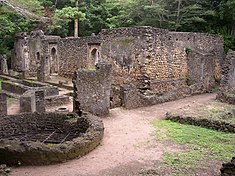
Back الإسلام في كينيا Arabic Islam au Kenya French Islam di Kenya ID Islam di Kenya Malay Islam in Kenia Dutch Islamismo no Quênia Portuguese Uislamu nchini Kenya Swahili Кениядә ислам Tatar

| Islam by country |
|---|
 |
|
|
Kenya has a Christian majority, with Islam being the second largest faith representing 11% of the Kenyan population, or approximately 5.2 million people as of the 2019 census.[1] The Kenyan coast is mostly populated by Muslims. Nairobi has several mosques and a notable Muslim population. The faith was introduced by merchants visiting the Swahili coast, which led to local conversions and foreign Muslims becoming assimilated. This would later result in the emergence of several officially Muslim political entities in the region.[2][3]
The majority of Muslims in Kenya are Sunni Muslims forming 81% of the Muslim Population, 7% identify as Shia.[4] There are also sizeable populations of Ibadism and Quranist adherents.[5] In large part, Shias are Ismailis descended from or influenced by oceanic traders from the Middle East and India. These Shia Muslims include the Dawoodi Bohra, who number some 6,000–8,000 in the country.[6] As for the orthodox Twelver Shia presence in Kenya, twentieth-century Pakistani scholar Khwaja Muhammad Latif Ansari played an important role in proselytisation for the resident Khoja community.[7][8]
- ^ "2019 Kenya Population and Housing Census Volume IV: Distribution of Population by Socio-Economic Characteristics". Kenya National Bureau of Statistics. Retrieved 24 March 2020.
- ^ Nkirote., Maingi, Anne. The diversity factor in the history of Islam in Nairobi, 1900–1963. OCLC 61571423.
{{cite book}}: CS1 maint: multiple names: authors list (link) - ^ Ayubi, Shaheen; Mohyuddin, Sakina (1994-01-01). "Muslims in Kenya: an overview". Institute of Muslim Minority Affairs Journal. 15 (1–2): 144–156. doi:10.1080/02666959408716313. ISSN 0266-6952.
- ^ "Chapter 1: Religious Affiliation". The World’s Muslims: Unity and Diversity. Pew Research Center's Religion & Public Life Project. August 9, 2012. Retrieved 4 September 2013.
- ^ "The World's Muslims: Unity and Diversity" (PDF). Pew Forum on Religious & Public life. August 9, 2012. Archived from the original (PDF) on October 24, 2012. Retrieved August 14, 2012.
- ^ Helene Charton-Bigot, Deyssi Rodriguez-Torres. Nairobi Today. the Paradox of a Fragmented City. African Books Collective, 2010. ISBN 9987-08-093-6, ISBN 978-9987-08-093-9. Pg 239
- ^ Cite error: The named reference
dewaniwas invoked but never defined (see the help page). - ^ Cite error: The named reference
khojawas invoked but never defined (see the help page).